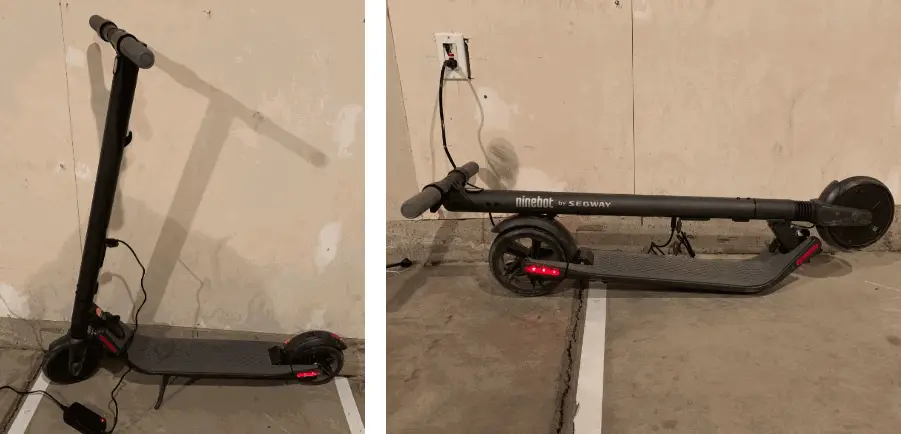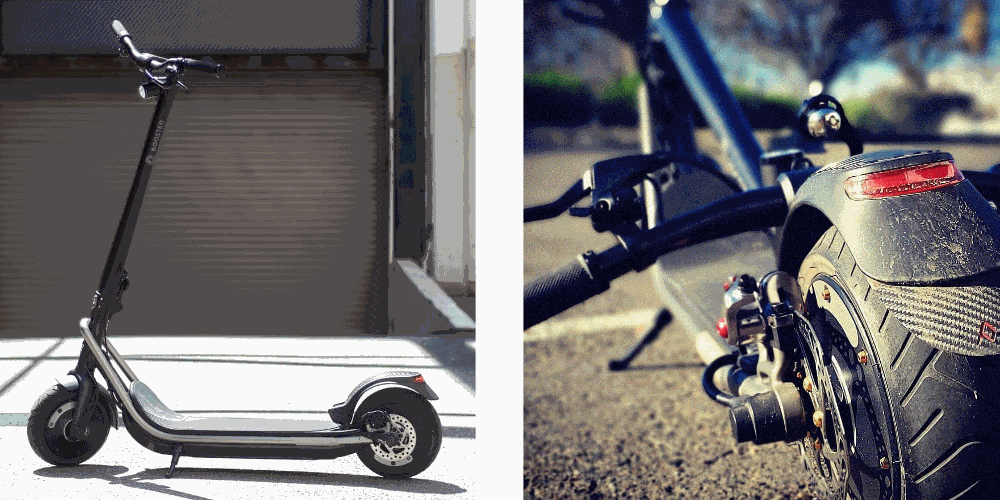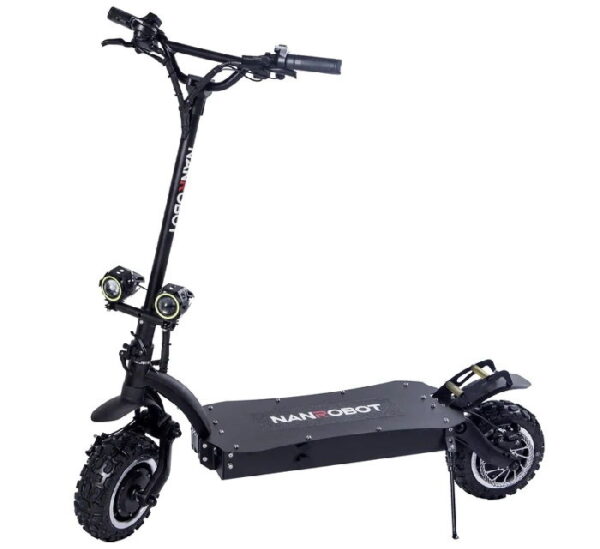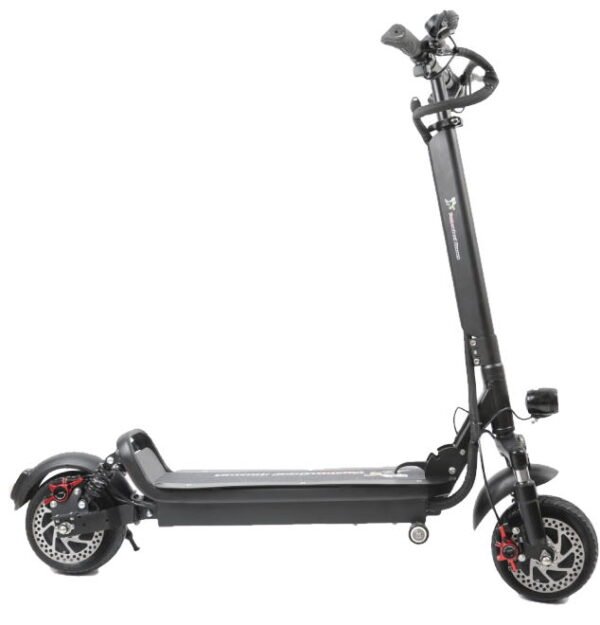Xiaomi M365 Review
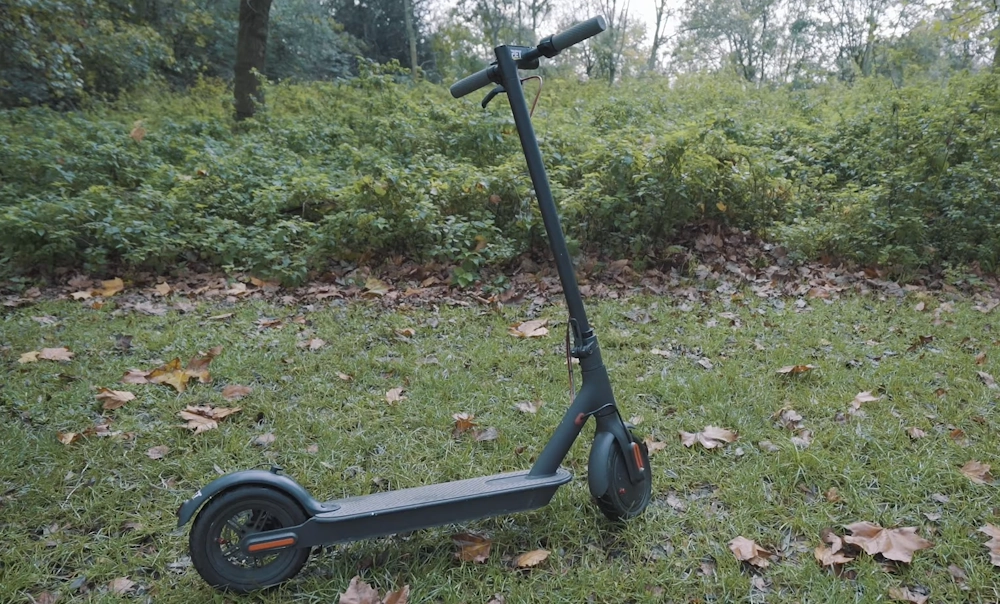

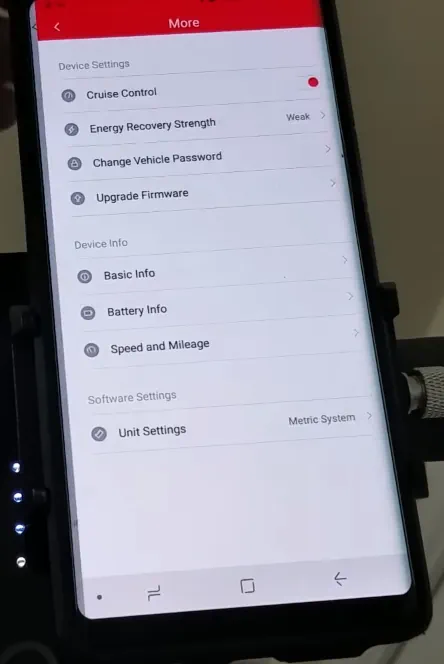

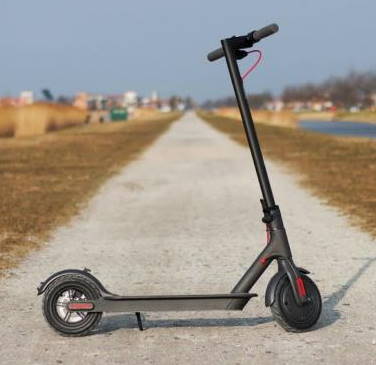
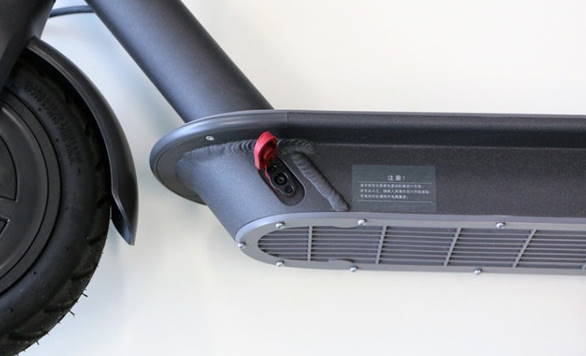


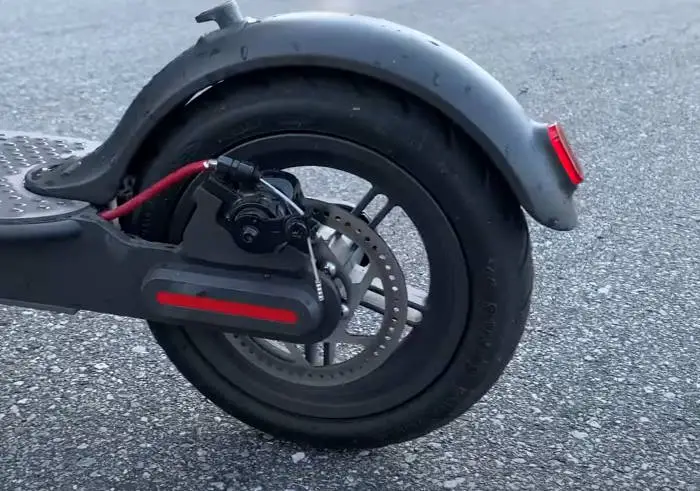
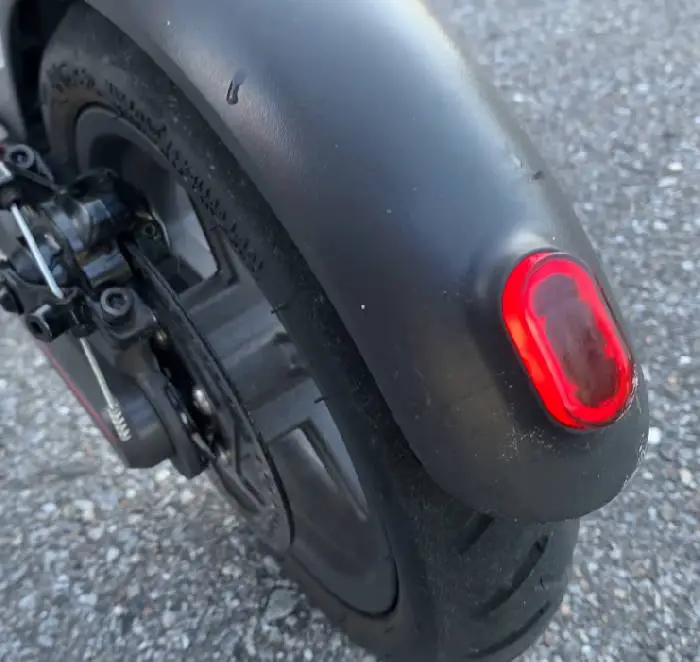
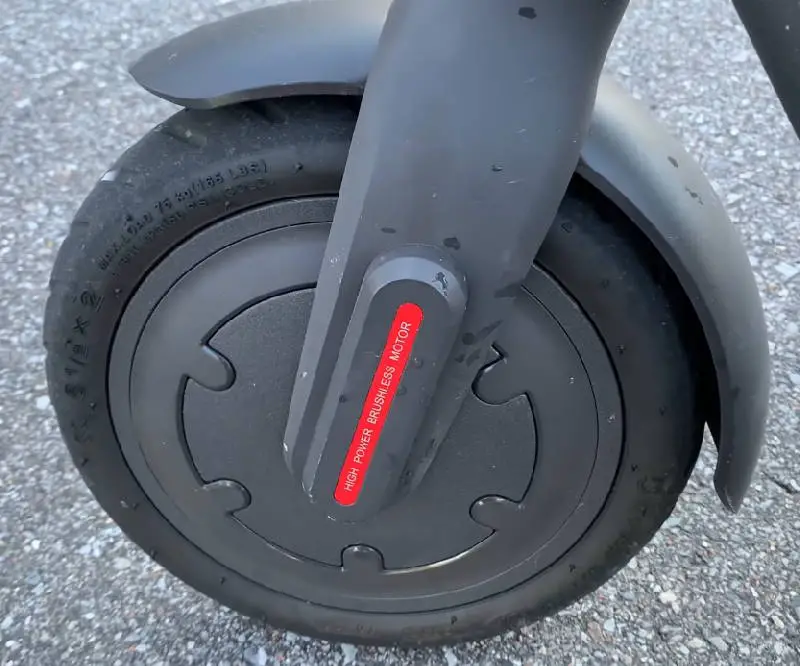
Xiaomi M365 Specifications
- Top speed: 25 kmh 15.5 mph
- Range: 30 km 18.6 mph
- Motors: single hub BLDC
- Power: 250 W real, 500 W peak
- Climb angle: 14 °
- Torque: 16 Nm
- Battery: 280 Wh, 36 V
- Battery type: smart BMS
- Charging time: 5 h
- Avg. charging cost: US: $0.05, Canada: $0.03, UK: £0.09, EU: €0.08
- Ingress protection (IP): IP54
- Weight: 12 kg 26.5 lbs
- Weight limit: 100 kg 220 lbs
- Tire size: 8.5 in
- Tire type: pneumatic road
- Tire pressure: 45-50 psi
- Foldable: yes
- Foldable handlebars: no
- Seat: no (customization possible)
- Trunk or basket: no (customization possible)
- Build material: aerospace-grade aluminum
- Terrains: cement, asphalt, flat soil pavements, bumps or steps less than 1cm high, less than 3cm wide
- Brakes: regenerative + disc braking, braking distance 4m
- ABS: yes
- Shock absorbers: no (customization available)
- Lights: headlight + brake lights
- Control: LCD display
- Speed modes: 3
- Cruise control: yes
- Keys: no
- Alarm: no
- App: iOS, Android
- Warranty: 12 – 24 months
- Rider age: 16-50
- Folded dimensions (L * W * H): 108 * 43 * 49 cm 42.52 * 16.93 * 19.29 in
- Unfolded dimensions (L * W * H): 108 * 43 * 114 cm 42.52 * 16.93 * 44.88 in
- Deck dimensions (L * W): 40 * 14 cm 15.75 * 5.51 in
- Ground clearance: 8.7 cm 3.43 in
- Deck to handlebar height: 95.2 cm 37.48 in
- Rider height: 120 – 200 cm 47.24-78.74 in
- Adjustable handlebar: no
- Notes: hack available, increases top speed and power
Tests and measurements
- Speed tests (EScooterNerds): 25 kmh 15.5 mph
- Speed tests (third party): 25 kmh 15.5 mph
- Range tests (EScooterNerds): 31 km 19 mi
- Range tests (third party): 30 km 18.6 mi
- Braking distance tests (EScooterNerds): 5 m
- Braking distance tests (third party): 5 m
- Climb tests (EScooterNerds): 15
- Climb tests (third party): 15,17
- Weight limit tests (EScooterNerds): 91 kg 201 lbs
- Weight limit tests (third party): 100/94 kg 220/207 lbs
- Waterproofing tests (EScooterNerds): no issues in rain or snow
- Waterproofing tests (third party): no issues in light rain
Ratings and scores
Pros
- best-selling scooter ever
- great value for money (one of the best maybe)
- very good quality
- simple to use and great for beginners
- pretty good for commuting
- portable
- smooth rides
- good brakes
- good water protection
Cons
- vulnerable to flats
- average speed (can be increased with a hack)
- average range
- not the best option for heavier riders
- mediocre folding mechanism
When to buy
This is the quintessential electric scooter, the one that practically started the whole thing, so you can’t really go wrong with it if you’re looking for your first scooter.
When not to buy
If you’re an advanced rider or want a fast or off-road scooter, this will not be a great option.
The Xiaomi M365 is the most iconic electric scooter ever, and it’s a top pick in the budget-friendly category. For many, it’s the go-to image when thinking of electric scooters.
Having owned and extensively used this scooter, I’ll delve into what has propelled it to become the best selling scooter of all time.
Xiaomi M365 basics
The Xiaomi M365 is a classic kick-to-start scooter, and it requires a light kick off the ground and some initial speed before it can start accelerating on its own.
Many may disagree with me on this one, but I strongly believe that kick-to-start scooters are superior to zero-start scooters.
The kick-start process is minimal and user-friendly, making the scooter easy for everyone to use, and I am pretty sure everyone can figure out how to use it even on their own in just under a minute
With a thumb throttle for acceleration, a brake lever, and a central power button, it’s straightforward and popular for a reason. When the scooter is on, a quick press of the power button toggles the lights on or off.
A double-press changes between the two speed modes, which is indicated by the lowest dot on the screen. Each speed mode has its own speed limit:
- eco (11 mph / 18 kmh), the indicator light is green
- standard (15.5 mph / 25 kmh), the indicator light is white
Unboxing and assembly

Your scooter will likely arrive at your home in a fairly plain brown box, with lots of protective coverings around all of the components.
The box will include:
- scooter
- handlebars
- charger
- toolkit
- screws
- tire pump valve
- user manual
- quickstart guide
- warranty card
- spare tires (only with some retailers)
Minimal assembly is needed before riding, taking less than 5 minutes. Connect the handlebars to the stem, and ensure the cables are connected. Screw the four screws on the stem (two front, two back).
Confirm that the brakes work, tires are inflated, and the battery is charged.
I recommend not throwing away the packaging at least until your return period expires, as you may need it in case you decide you want to return the scooter.
User manual
The Xiaomi M365 user manual is short and informative.
While manuals may not be everyone’s favorite, I recommend reading or skimming through it for valuable insights specific to your version.
Folding and unfolding
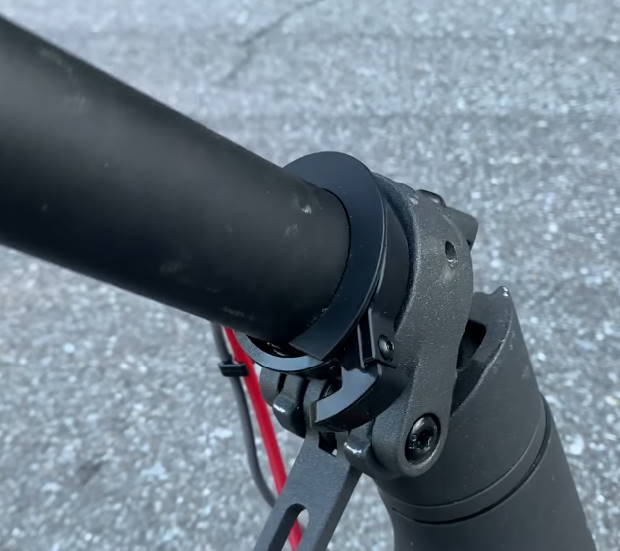
The Xiaomi M365’s folding mechanism is widely imitated but groundbreaking.
To fold, unlock two latches, twist the smaller one, and pull down the larger one. Secure the folded stem by connecting the handlebar frame with the rear fender hook.
Unfolding is the reverse, ensuring a secure “click.”
The handlebars don’t fold and are fixed at a suitable height for most riders between 3’9” / 120 cm and 6’6” / 200 cm. The folding issues that were reported in 2019/2020 have been significantly improved, and it now offers a well-balanced and secure mechanism.
Performance
Next we will describe the performance aspects of the Xiaomi M365.
Motor

The Xiaomi M365 has a brushless DC hub motor, with a real power of 250 Watts and a peak power of 500 Watts.
Despite its modest rating, it delivers reliable and impressive performance, comparable to scooters with 350 Watt motors.
The front-wheel placement enhances torque and overall power, surpassing expectations in speed, acceleration, and climbing, outperforming many other 250 Watt scooters.
Speed and speed test
The Xiaomi M365 comes with an official top speed of 15.5 mph / 25 kmh, and I never had any issues reaching this speed, even when the battery wasn’t fully charged.
The scooter only struggled to reach that speed when the battery was nearly empty.
One time I was curious if the Xiaomi M365 could reach a bigger max speed. So, I took it on an open road and the results were 17 mph / 27 kmh. It was quite the nice surprise.
The acceleration of the Xiaomi M365 is one of its strong points and one of my favorite feats. While the scooter doesn’t come with a particularly powerful motor, it still accelerates quite fast and takes just under 6 seconds to reach full speed.
If you aren’t satisfied with this speed and want more wind in your hair check out my guide on the fastest electric scooters.
Climbing and climb test
I found the Xiaomi M365 to be a good climber, but not a great one. To be fair, pretty much no scooter in this price range is a great climber, and compared to its peers, the Xiaomi M365 actually climbs quite well.
The official climb angle is 14° / 25%, although my own experience and climb tests indicated that the scooter would likely conquer hills of up to 20° / 36%.
So, the scooter will climb the typical everyday hill most of us encounter on our daily rides, and while it will slow down significantly on steeper hills, it may still eat up many of them.
If you are one of those junkies who like climbing the steepest hills, check out my guide on the best hill-climbing electric scooters.
Range and range test
Officially, the range of the Xiaomi M365 is 18.6 mi / 30 km. Almost all of my range tests confirmed this range, with the average result of most them being around 17.5 mi / 28 km.
Xiaomi M365 after one year of usage
The Xiaomi M365 isn’t just stylish, it seamlessly fits into my urban lifestyle. Its gentle acceleration, responsive handling, and comfortable ride make commuting a breeze.
The 8.5-inch pneumatic tires navigate uneven terrain effortlessly. Maneuvering through traffic feels intuitive, and cruise control adds convenience on longer rides.
The bright LED lights ensure safety after dark.
For sure, I can say that my Xiaomi has provided a secure and joyful ride every time. The only problem I have had with the Xiaomi is with the range and battery.
It will probably decrease by about 15%-20% from the day you first bought your scooter, and maybe even more if you don’t take proper care of the battery.
Xiaomi M365 vs other electric scooters
This is how the evergreen Xiaomi M365 compares to other electric scooters.
Xiaomi M365 vs Xiaomi M365 Pro
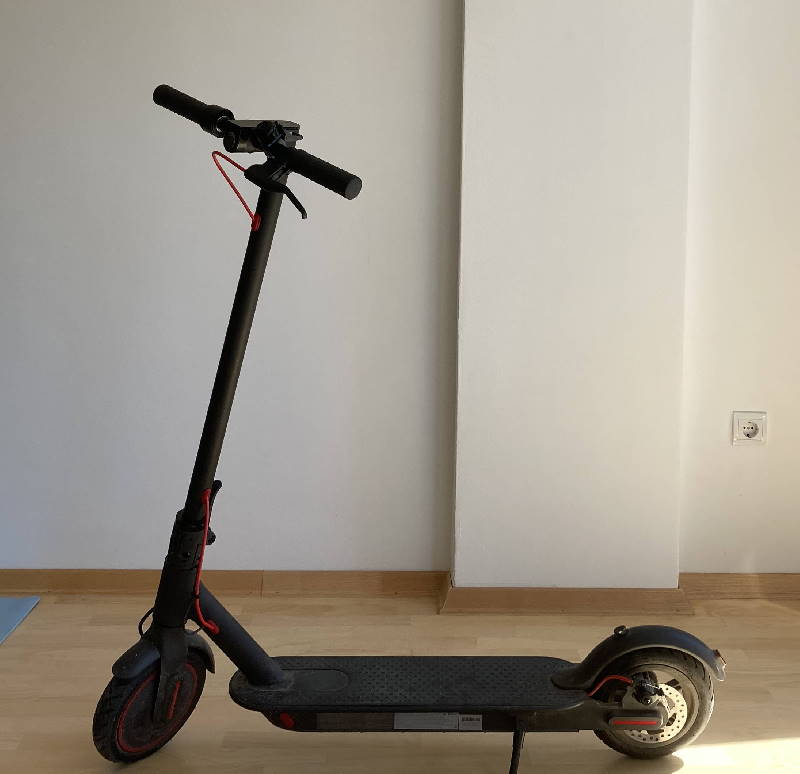
This is one of the most common comparisons in the scooter world ever, and probably a question that every potential new scooter owner should ask themselves.
While both scooters are excellent, the Pro version, being the upgrade, is a superior choice in many scenarios.
However, the Xiaomi M365 is more budget-friendly. The Pro justifies its higher price with enhanced performance, bug fixes, and refinements, making it a mid-priced scooter around $600.
If you’re on a budget, the original Xiaomi M365, with a lower price, remains a competitive option. The Pro is also slightly heavier and takes longer to charge.
Personally, I myself went with the Xiaomi M365 Pro (you can read my full review here), and I would probably recommend that choice to most new scooterists today.
But, as I said, if you are not planning on spending more than $450-$500 on a scooter, then you will probably want to stick with the original version.
Xiaomi M365 vs Xiaomi Pro 2
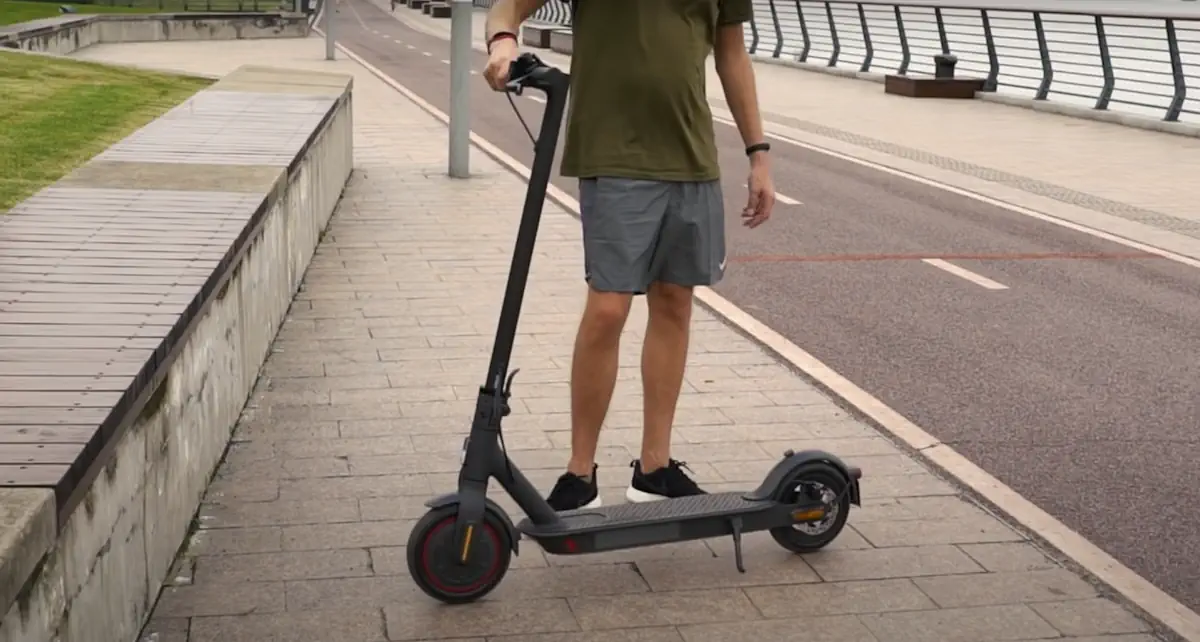
This is pretty much the same as comparing the Xiaomi M365 and the Xiaomi M365 Pro, but by making the Pro even a bit better and slightly more expensive as well.
That further gap in the price difference is justified by mostly minor improvements, as the performance and the general features of the Pro and the Pro 2 are generally the same.
You can see the complete review of the Xiaomi Pro 2 to find out more.
Xiaomi M365 vs Ninebot ES2
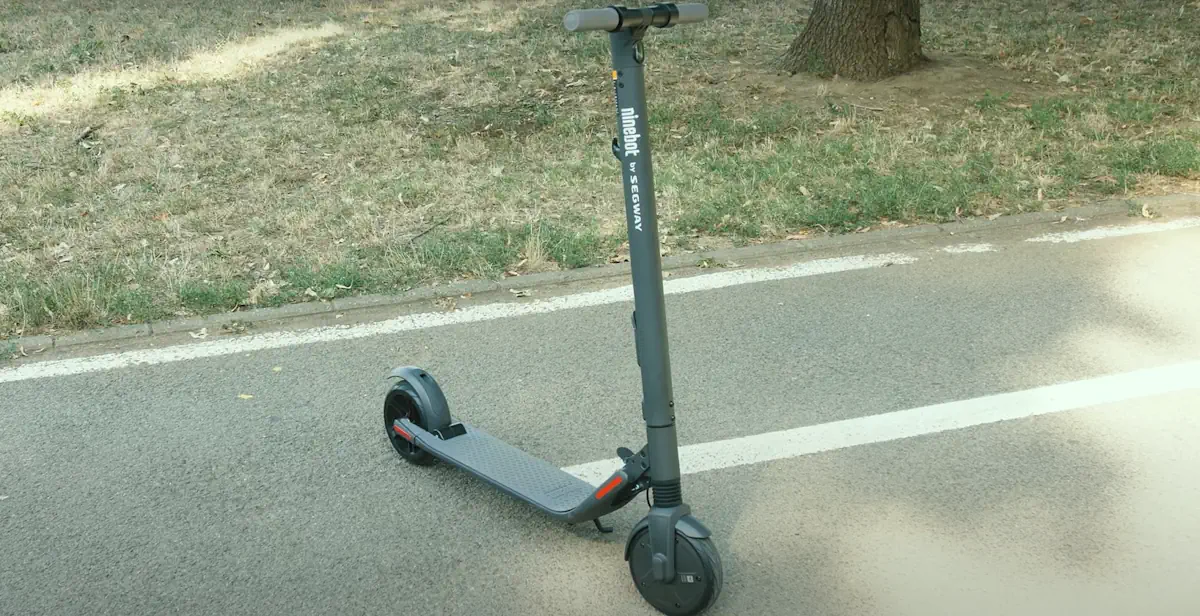
Some consider the Ninebot ES2 (full review here) to be the biggest rival of the Xiaomi M365.
In my opinion, the choice is clear, as the wheel differences between the two scooters make it evident. For a budget option with solid wheels, the Ninebot ES2 stands out.
If you prioritize ride comfort with pneumatic tires, accepting a slight risk of flats, the Xiaomi M365 is the preferred option.
Xiaomi M365 vs Ninebot Max
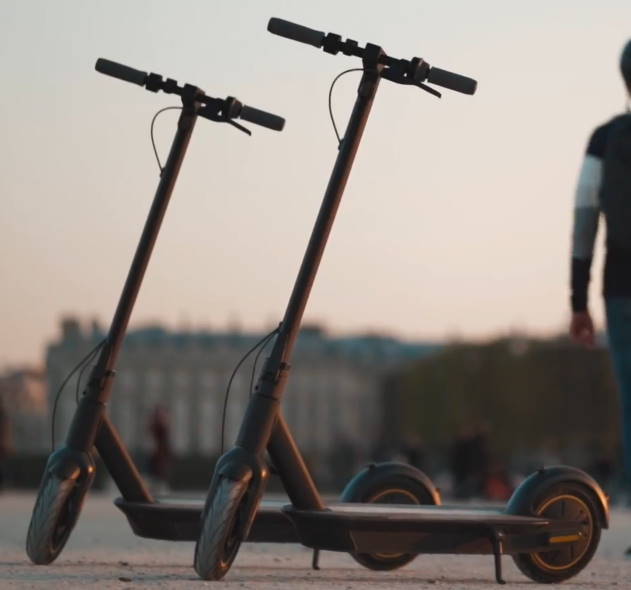
I think that the comparison may not be entirely fair, considering the significant price difference between the Xiaomi M365 and the Ninebot Max. Priced at almost half, the Xiaomi M365 targets a different budget range.
However, if your budget allows for around $800, the Ninebot Max is a highly recommended choice. With superior range, speed, and power, it’s a well-received scooter, albeit heavier at 42 lbs / 19 kg.
In essence, the Ninebot Max is a more advanced, powerful, and premium option, ideal for those seeking a second scooter. If you want to find out more then check out the full review of the Ninebot Max.
Xiaomi M365 vs GoTrax GXL V2 Commuter
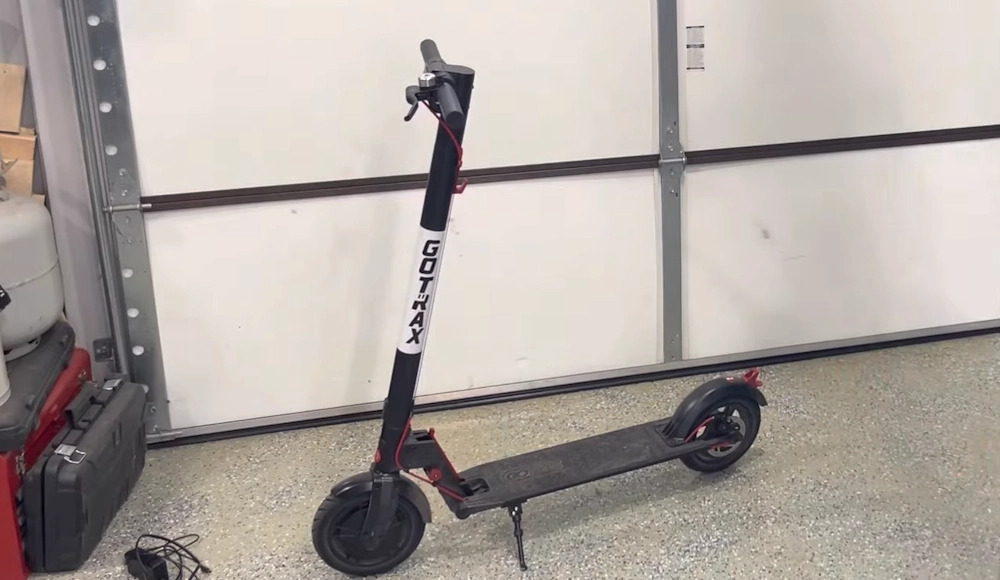
The GoTrax GXL V2 Commuter is an ultra-budget scooter compared to the Xiaomi M365, which falls into the budget category.
While the Xiaomi M365 offers superior quality, performance, and popularity, the GXL V2 is a compelling option for those seeking the most affordable scooter that maintains reasonable quality.
The Xiaomi M365, with its optimal balance of price and features, is likely the preferred choice for most users.
In fact, I believe the GoTrax GXL V2 Commuter to be the cheapest electric scooter that can still be labeled as good with a straight face. It only costs around $250 – $300. You can read the full review of the GoTrax GXL V2 Commuter if you’re interested in something like that.
Xiaomi M365 vs GoTrax XR Ultra
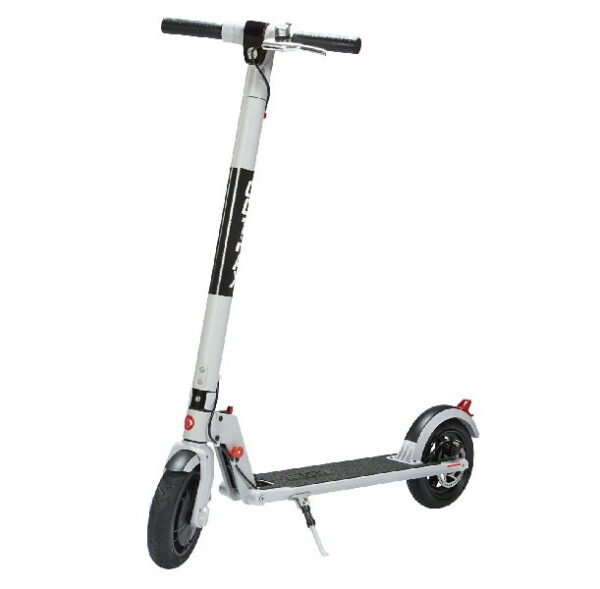
The prices of these two scooters are comparable, but with the GoTrax XR Ultra (full review here), you will still save about $100 on average.
The additional $100 for the Xiaomi M365 is a worthwhile investment, and I recommend it for most new scooterists. While the specs are comparable, the Xiaomi M365 offers better range and overall build quality.
Although the GoTrax XR Ultra has a slightly more powerful motor, the Xiaomi’s brand recognition and popularity make it the superior choice with more data and user experience to draw from.
Xiaomi M365 vs Hiboy S2
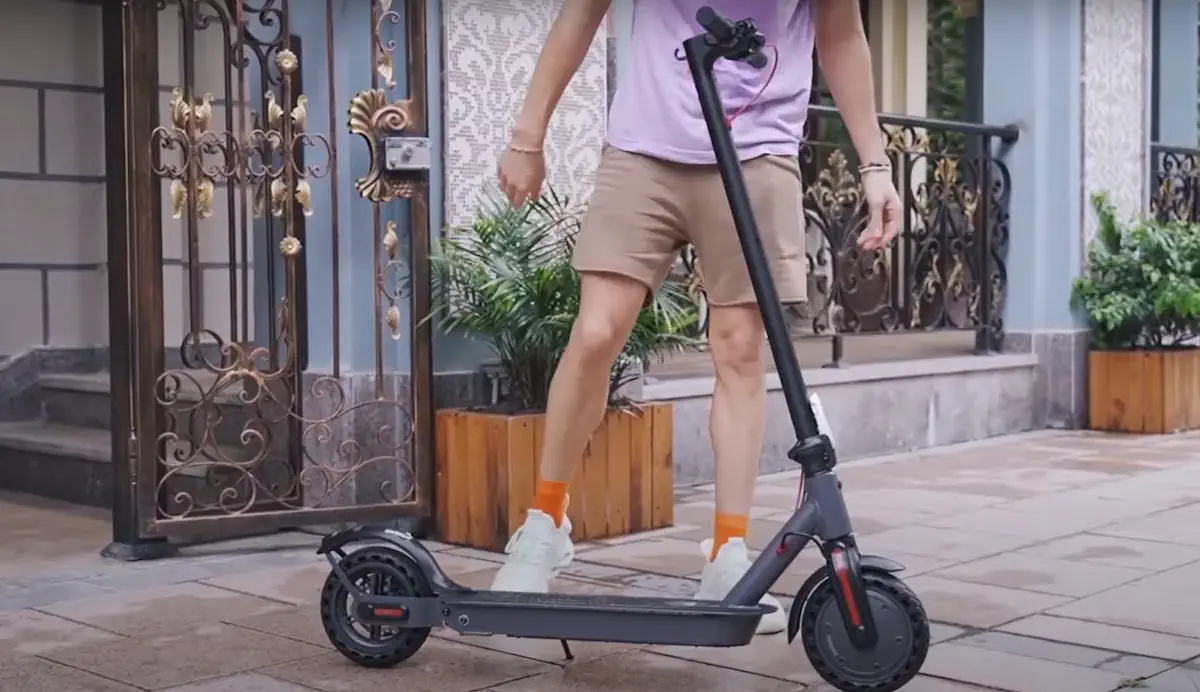
The Xiaomi M365 and the Hiboy S2, both priced under $500, offer similar performance. The Hiboy S2 is slightly faster with a higher weight capacity, while the Xiaomi M365 provides more range and better climbing ability while being lighter.
Despite their similarities, they target different preferences.
The Hiboy S2 is a solid-tire scooter, and that makes this choice easy for everyone. If you believe you may suffer flats often, and you simply want to avoid that headache, check out the Hiboy S2 review.
However, be aware that the immunity to flats will come at the price of shaky, bumpy, unstable rides, and usually, I don’t recommend making that tradeoff, so if you agree with that, stick with the Xiaomi M365.
Xiaomi M365 vs Kugoo S1 Pro
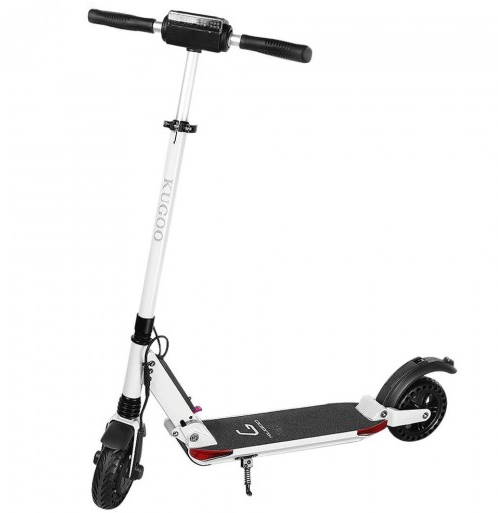
The Kugoo S1 Pro competes directly with the Xiaomi M365 in Europe. While they share similar ranges and motors, the S1 Pro offers a slightly higher top speed, better climb angle, and a lighter weight capacity for about $100 less.
However, the Xiaomi M365’s advantages are in the larger, air-filled tires contribute to a better ride quality, and its overall build quality is superior.
I would give the overall advantage to the Xiaomi M365, and maybe recommend the Kugoo S1 Pro for someone looking for a solid-tire scooter, or a scooter that’s strong in the areas where the Kugoo S1 Pro outshines the Xiaomi M365.
You can see the complete Kugoo S1 Pro review to find out more about it.
Xiaomi M365 vs Unagi Model One
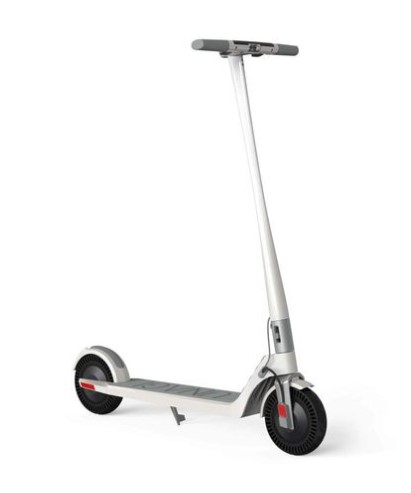
The Unagi Model One, despite its higher cost, features a weaker motor, limited climbing ability, and overall inferior performance compared to the Xiaomi M365.
With similar build quality, greater experience, and brand recognition at half the price, choosing the Xiaomi M365 over the Unagi Model One seems more reasonable.
If you are still considering the Unagi Model One, check out my review of it.
Xiaomi M365 vs Razor E300
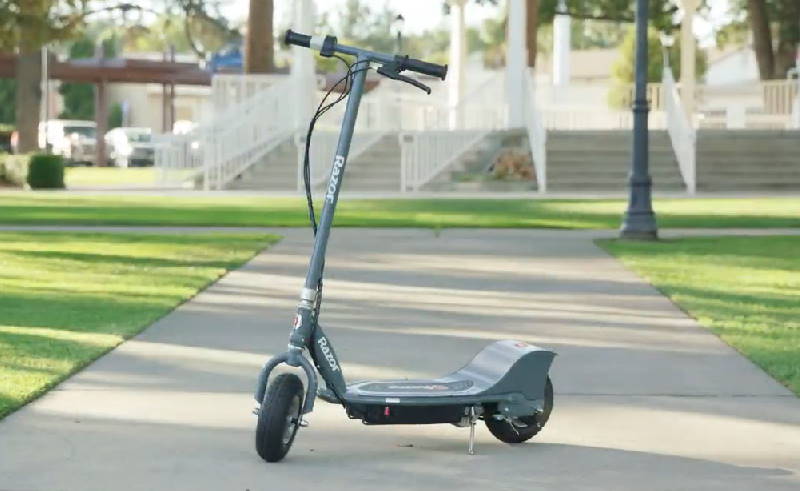
I don’t typically recommend the Razor E300 as a good scooter for adults. Despite its weight capacity, it’s essentially a kid’s scooter. The use of lead-acid batteries, an older technology, makes it less superior to scooters with lithium-ion batteries, including the Xiaomi M365.
For younger children, the Razor E300 might be considered, but for those older than 15-16, opting for the Xiaomi M365 from the start is a better choice.
If you still prefer the Razor E300 and want to find out more about it, check out my review.
Build quality and lifespan
The Xiaomi M365’s build quality has impressed me with its durability. The aircraft-grade aluminum frame feels sturdy and stable, while the well-made components like the pneumatic tires and mechanical brakes ensure a comfortable and safe ride.
The attention to detail shines through in the smooth folding mechanism and sleek design, and my personal experience confirms its long-lasting performance.
While minor areas like the kickstand could be improved, they don’t significantly impact the overall experience. If you’re seeking a reliable and affordable scooter for urban adventures, the Xiaomi M365’s exceptional build quality makes it a great choice.
On average, the Xiaomi M365 can last around 3 to 3.5 years, but it’s not uncommon for it to last 5+ years.
While some may experience issues in the first year, such cases are relatively rare and decreasing over time (just around 5% of owners will see their scooter suffer a serious malfunction in the first year, you can see the full research here).
Features
Here are some of the features of the Xiaomi M365.
Battery and charging

The Xiaomi M365 features a 36V, 280Wh battery that fully charges in 5-5.5 hours. Most users typically charge for 2-3 hours, while older batteries may take up to 6 hours.
The smart battery management system safeguards against common issues. The charging port, located on the front left of the deck, is protected by a water-resistant red cap.
How much does it cost to charge the Xiaomi M365?
Depending on the country, charging the Xiaomi M365 from empty to full battery costs:
- USA : 0.04 (peak) / 0.01 (off-peak)
- UK : 0.08 (peak) / 0.06 (off-peak)
- Canada : 0.03 (peak) / 0.03 (off-peak)
- Australia : 0.07 (peak) / 0.03 (off-peak)
- France : 0.06 (peak) / 0.04 (off-peak)
- Germany : 0.10 (peak) / 0.03 (off-peak)
- Russia : 0.02 (peak) / 0.01 (off-peak)
- China : 0.02 (peak) / 0.01 (off-peak)
- Japan : 0.08 (peak) / 0.06 (off-peak)
- Indonesia : 0.03 (peak) / 0.01 (off-peak)
- Philippines : 0.06 (peak) / 0.05 (off-peak)
- India : 0.02 (peak) / 0.003 (off-peak)
- Israel : 0.05 (peak) / 0.04 (off-peak)
- Brazil : 0.05 (peak) / 0.03 (off-peak)
Deck and stem
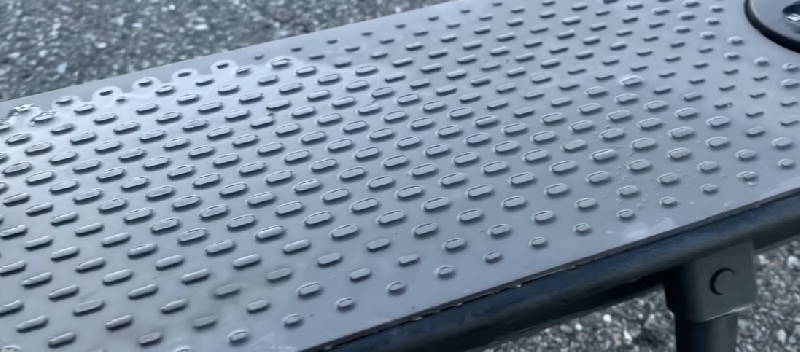
The scooter’s body, stem, and deck are crafted from durable aerospace-grade aluminum alloy, ensuring toughness and lightness. Non-electronic components include rubber and plastic.
The improved folding mechanism contributes to one of the sturdiest and most stable stem configurations among budget scooters, minimizing shakes.
The deck’s dimensions are 16×5.5 in / 40×14 cm and boasts a 3.5 in / 9 cm ground clearance.
In my opinion, one possible issue with the deck is that the glue that sticks the rubber cover to the deck may dry off over time, and the mat may start to come off. This is easily fixable with just some extra glue.
The kickstand of the scooter is big enough for the scooter to lean on it without the danger of tipping over.
Brakes and safety

The Xiaomi M365 ensures safety with a dual braking system—front electronic brake and rear disk brake—activated by the left handlebar lever.
The braking distance from full speed ranges between 16.5 and 19.8 feet / 5-6 meters.
In my opinion, the visible brake cable (usually red) is a minor design flaw, though fully internal cables are rare in scooters. The regenerative braking feature replenishes the battery with energy recovery during braking.
Personally, I found the braking system to be quite good, especially for a budget scooter. It is both responsive and gradual.
Tires, wheels, and fenders

The tires of the Xiaomi M365 are 8.5 inches in diameter, with a profile of 2.5 inches. They are air-filled, with inner tubes, and have some treads to provide better traction.
Both of the wheels have mudguard fenders, which provide decent protection from splashes (although the rear fender has been known to wobble a bit, especially in older versions).
The recommended tire pressure is 45 to 50 PSI.
Weight, dimensions, and portability
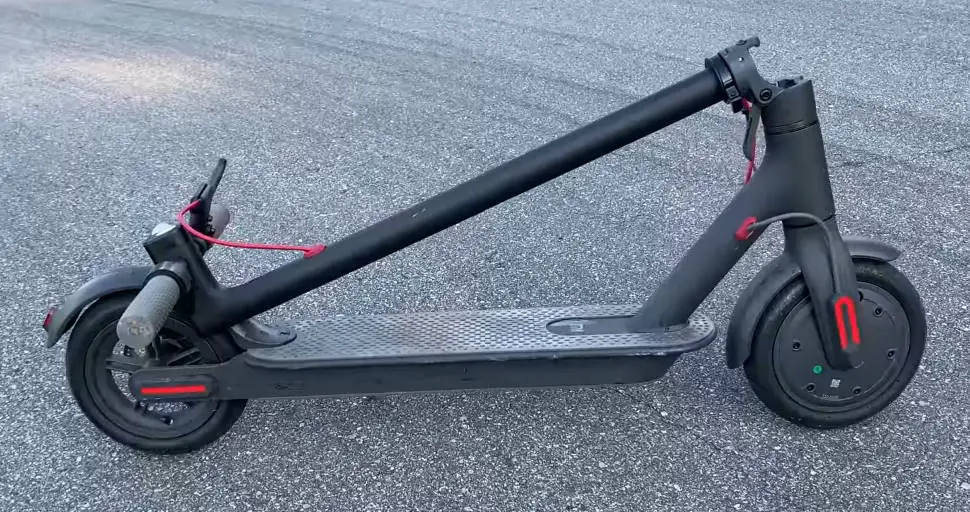
The Xiaomi M365 weighs 27 lbs / 12 kg, which makes it a few lbs/kg lighter than the typical budget commuter, and fairly easy to carry by most adults (I’ve seen a 12-year-old girl chase a bus for half a block with this scooter in her hands, and she caught the bus successfully with time to spare, so this is truly not a heavy scooter).
When folded, the scooter’s dimensions are:
- 42.5 in / 108 cm
- 17 in / 43 cm
- 19 in / 49 cm
The Xiaomi M365 is highly portable, with a small weight, folded volume, and stem diameter. While the folded scooter has a slightly steeper front angle, affecting the center of gravity during carrying, it remains generally portable.
It fits effortlessly in car trunks, including compact ones like a Ford Fiesta (which is what I used as a trunk test), and is suitable for public transport and office spaces.
I’ve tried pulling the folded scooter like a trolley by grabbing the handlebars and dragging it, and while it can be done, it’s not that convenient to do for longer distances.
If you don’t want to carry it, I suggest simply pushing it.
Weight limit and usage by heavy adults
The official weight limit of the Xiaomi M365 is 220 lbs / 100 kg.
When I was testing the scooter, I mostly weighed around 200 lbs / 90 kg. I can’t be entirely sure about this, but I do believe that I would have got a bit more range if I weighed less.
I probably wouldn’t recommend this as the best scooter for heavy adults.
Water resistance
The Xiaomi M365 boasts an IP54 water protection rating, which is a gold standard in the industry, surpassing many scooters with no water protection.
If you want to drive a scooter more frequently in the rain without any worrying check out my guide on the best waterproof and water-resistant electric scooter.
Lights and riding at night
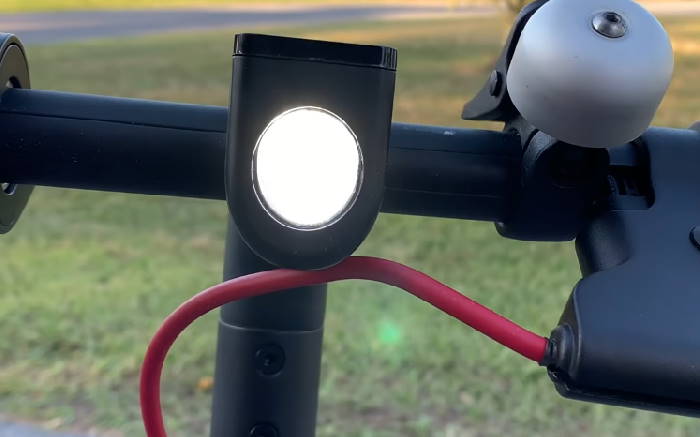
The Xiaomi M365 features an LED headlight on the handlebars, illuminating the road for about 16 feet.
For night riding, consider a brighter aftermarket headlight. The rear fender has a red brake light that blinks during braking or stays on with the lights.
Screen and cockpit
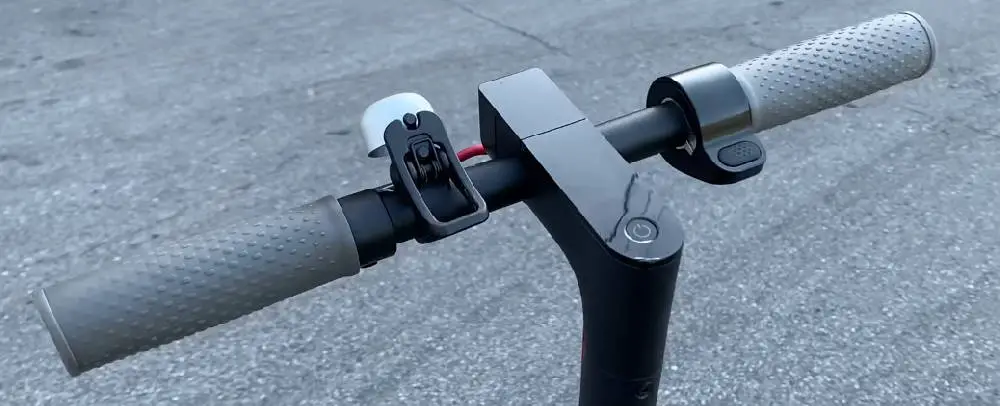
I believe the cockpit of the Xiaomi M365 to be one of its major weaknesses.
The right handlebar’s acceleration throttle is sensitive and well-placed, while the left handlebar’s brake lever functions as expected. The bell on the left is not very loud, and while suitable for alerting pedestrians, it may struggle in noisy environments.
The display, with only 4 vertical dots, is basic, indicating speed mode and battery level.
Despite its simplicity, the Xiaomi M365, designed in 2016, remains influential in the electric scooter industry, with detailed information accessible through the phone app.
App
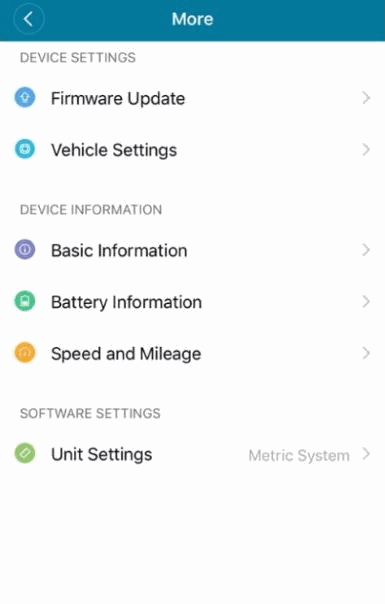
The official Xiaomi Home app is used to connect with the scooter through bluetooth, and it is available for both iOS and Android.
Don’t let the seemingly subpar reviews on both platforms fool you – they are mostly from older reviews, plus bluetooth connectivity is a common issue in this type of app, and both apps are quite better than most other scooter apps.
The app comes with many useful features, and lets you read or control:
- current speed
- distance traveled
- battery level
- speed mode
- lock the scooter
- toggle cruise control
- set the regenerative braking configuration
In addition to the official app, I recommend trying out the EScooterNerds Universal Scooter Helper App, available for both iOS and Android as well.
The app isn’t meant to be a replacement for the original app, and it should work together with it, giving you additional features like checklists, guides, hacks, tools, resources, calculators, etc.
Accessories and customizations
Not only does the Xiaomi M365 have a ton of after-market accessories available specifically for it, but it will be able to host the majority of the generic scooter accessories and customizations, as its build and design basically dictate the way the “default” scooter looks like.
Helmet
The Xiaomi M365 requires a helmet for safety, protecting against injuries and legal issues.
Check the electric scooter helmet guide for a suitable, budget-friendly option with the necessary protection levels and certifications.
Seat
Consider adding a seat to your Xiaomi M365 for added comfort.
The scooter can accommodate one, and users commonly customize it this way. You’ll need to drill holes for the seat frame, a straightforward task. You can see the VBestLife Shockproof Seat for Xiaomi on Amazon for a great pick.
Trunk
A trunk placed on the stem is another super-useful accessory that you can get for cheap. Most trunks will probably fit the Xiaomi M365, although the Epessa Bag on Amazon is proven to be fully compatible and is very affordable.
Downsides, issues, and tradeoffs
The Xiaomi M365, like any affordable scooter, has some issues.
The primary concern is its vulnerability to flats, a well-documented problem that, although improving, remains a significant issue.
Fixing flats can be challenging, and potential buyers should be aware of this issue.
Now, I believe this is somewhat overblown, and a lot of flats are just a consequence of improper riding or plain ol’ abuse. But still, you shouldn’t be surprised if you get one, two, and maybe even three flats a year with this scooter.
If you’re okay with occasional flats, other issues are likely less significant. Some are remnants from previous versions, possibly addressed in newer releases.
The once prevalent folding mechanism instability, reported mainly in 2019-2020, has diminished over time. Xiaomi’s commitment to user feedback reduces the likelihood of encountering this problem in recent models.
Another common issue may be the shaking and vibration of the rear fender. Now, this issue is still somewhat present, and there is a small chance of some owners being affected. This is almost never a serious issue though.
Those are pretty much all the downsides of the Xiaomi M365. All in all, I believe that this is a very small number of faults for a scooter this cheap, and Xiaomi has done an excellent job overall on the build quality.
What remains are the obvious tradeoffs.
The Xiaomi M365 is not some monster scooter capable of breaking the sound barrier or taking you on journeys that are dozens and dozens of miles long. If you are after a more performant scooter (usually if you’re picking your second scooter), you will almost certainly want to see some other options better suited for your particular use case:
- longest range electric scooters
- most powerful electric scooters
- best electric scooters for heavy adults
- best off-road electric scooters
Also, while the quality of the Xiaomi M365 is admirable for its price, this will still be a budget scooter, and if you’re after a more premium scooter, you’ll probably want to see some more luxurious scooters, or some of the best-designed scooters of today.
Verdict

The Xiaomi M365 is a versatile choice suitable for various scooterist categories. If you’re a newcomer to electric scooters or seeking your first purchase in this category, the Xiaomi M365 offers a reliable and accessible option.
If you’ve enjoyed riding scooters through ride-sharing services and now want one for personal use, the Xiaomi M365 is a popular and well-regarded choice.
Additionally, if you’re looking for the best scooter within the $400 – $500 budget range, the Xiaomi M365 stands out for its performance and features.
If your priority is a solid commuting scooter with a sufficient range, easy portability for car trunks and public transport, and an overall user-friendly design, the Xiaomi M365 is the only recommended option to consider in my mind.



